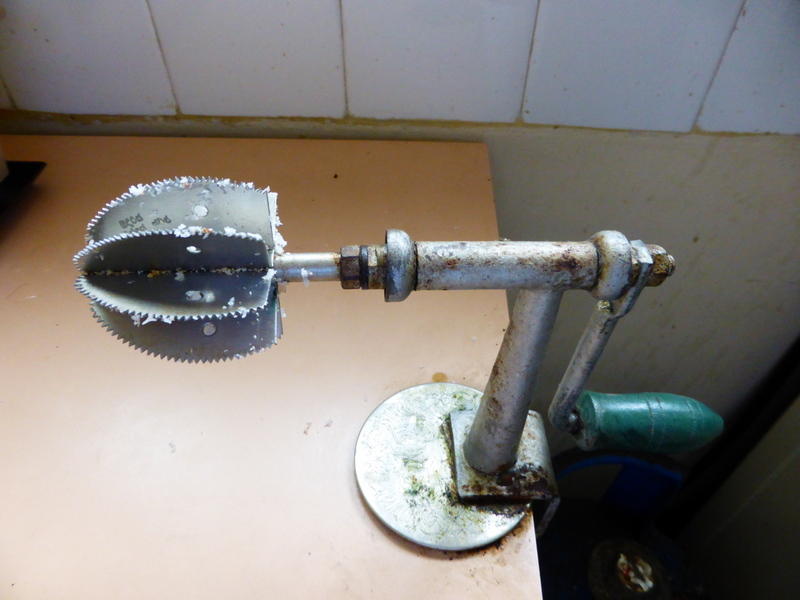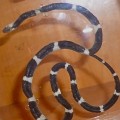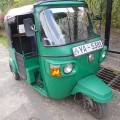Two or three times a year, the coconut boy comes around to harvest the coconuts. This year he was delayed as there has been so much rain it has left the palm trunks slippery.
There are six coconut palms (Cocos nucifera) in our garden here and they all have a ‘loverly bunch’ on them. Two of the trees are King Coconut, a variety of large yellow nut found in Sri Lanka.
They are full of liquid and used for drinking. The fluid has even been injected into veins when saline was not available in hospitals during WWII.

Harvesting Coconuts
The boy arrived, actually a middle aged, lithe, fit man. He ties his ankle together with a cloth, turns the soles of his feet inward and grips the trunk. Then he hoists himself up by his arms and brings his legs up after him. It takes just a few seconds to get up the tree.

Then the coconuts begin raining down; thud, thud, thud. Some bounce and roll down the bank. In all we harvested 36. Ira, the cook, is very happy as she gets to take some home.

Coconut products
Coconut is an important crop in the tropics.
The husk is fibrous and called coir. It is used for rope making, mats, caulking for boats, filling mattresses and as potting compound.
The ‘shell’ we are familiar with burns well and is used for making charcoal. It is also a useful container for fluids.

During Perahera, the elephant festival, men carry iron baskets filled with shells on poles. The shells burn to produce light. Each elephant has a man on the lookout for dropped burning shell. If an elephant were to tread on one, the festival could get really exciting.
The white endocarp inside is edible and called copra when dried. It has many culinary uses, not just to fill Bounty bars. It also produces coconut milk and butter which are the bases for many cosmetics.
My wife Brenda has a coconut grinder which gets the flesh out from the shell in a grated form. Mix this with various spices and it forms Sambol, a favourite Sri Lanka food.

Coconut trees need 6-10 years to get going then they produce 30-75 nuts a year. Strictly speaking they are not nuts but drupes. The botanical aficionados will know that palm trees have not learned how to grow branches, nor do they separate the xylem from the phloem in the trunks.
The trunks are straight and useful for structural purposes. Some people let the husk begin to germinate and then eat the ‘sprout’ inside the shell. Some take the apical sprout for a salad ‘heart of the palm’ but that kills the plant.
The roots are shallow and fibrous and grow throughout the life of the tree. Rarely is a palm tree uprooted in a hurricane. Toothbrushes can be made from roots and brooms from the fronds.
Sap
Then there is the business of tapping the sap from the flower. A tree will produce up to 8 gallons of sap a week. This can be fermented to make Toddy. Toddy can be distilled to make Arrack. Alternatively, the sap can be boiled down to a syrup, Kithul or treacle, or further reduced to leave sugar known as Juggery. Our standard breakfast is banana, buffalo curd and kithul. Sometimes we add a few cornflakes but a £6 a packet we have to be careful.
There seems no end to the inventiveness of what to do with a coconut palm.
Cocos nucifera needs a warm wet climate. It cannot survive frost. I am sorry but we cannot have them in our gardens in UK.
Post Series: Dispatches from Sri Lanka, by Mike Sedgwick:
2015
- A Loverly Bunch of Coconuts
- Agricultural Restaurant in Sri Lanka
- Back to Sri Lanka
- Bats and Hallowe’en
2014
- Dispatches From Sri Lanka
- Kandy Lake vs Chandler’s Ford Lakes
- Self-Employment In Sri Lanka
- Sri Lankan Wedding
- Sri Lankan Food
- There’s Some Corner Of A Foreign Field
- The Cultural Triangle of Sri Lanka
- This Is the Record Of John
- Tuk-tuk: My Transport Of Delight
- Life On The Road
- Commonwealth Games In Kandy
- A Temple For A Tooth?
- Dawn Train Down The Mountain To Colombo
- Traditional And Modern Medicine in Sri Lanka
- Ancient Vedda Tribe Becoming Extinct
Never miss out on another blog post. Subscribe here:






Mike – keep these blogs coming! It’s so fascinating to hear about different cultures.
Really looking forward to visiting Sri Lanka one day – you see you have me inspired!
Cheers for now,
Roger
Be patient, my friend. Two more posts are in the pipeline. 🙂
Always great to see life from a different perspective and world. Wonderful post, Mike.
This coconut grater seems like a more useful gadget than an iPad. In older days, I had a lot of dishes cooked with coconut. I would pick a coconut from a seller, then watched him ‘grind’ the coconut flesh into fine moist shredded coconut. You put them in a cloth, and squeeze the coconut cream out. Use it for cake, coconut flavoured rice…
My mother always says that coconut liquid may harm a woman’s health. Perhaps it has to do with some yin and yang theory. There might be a medical reason.
Mike
Wonderful posts – make us all envious of your winter sun.
Would you mind contacting me directly on nick@wessexcfb.co.uk – I would like to email you and ask your advice about travel to Sri Lanka please. We are planning big family holiday next summer and local knowledge is always preferred!